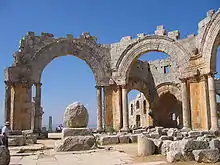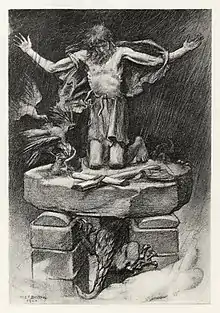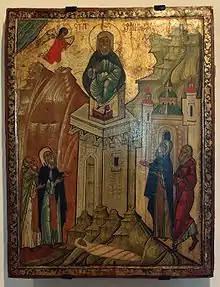Simeon Stylites
Simeon Stylites or Symeon the Stylite (Classical Syriac: ܫܡܥܘܢ ܕܐܣܛܘܢܐ šamʻun dasṯonáyá, Koine Greek Συμεών ὁ στυλίτης Symeón o Stylítis, Arabic: سمعان العمودي Simʿān al-ʿAmūdī) (c. 390? – 2 September 459) was a Syrian ascetic saint who achieved notability for living 37 years on a small platform on top of a pillar near Aleppo (in modern Syria). Several other stylites later followed his model (the Greek word style means "pillar"). He is known formally as Simeon Stylites the Elder to distinguish him from Simeon Stylites the Younger, Simeon Stylites III, and Symeon Stylites of Lesbos.
Saint Simeon Stylites | |
|---|---|
.jpg.webp) 6th-century depiction of Simeon on his column. A scallop shell symbolizing spiritual purity blesses Simeon; the serpent represents demonic temptations (Louvre). | |
| Venerable Father | |
| Born | c. 390? Sis, Adana Province, Turkey |
| Died | 2 September 459 (aged 68–69)[1][2] Qalaat Semaan, Byzantine Syria (between Aleppo and Antioch) |
| Venerated in | Oriental Orthodox Church Eastern Orthodox Church Roman Catholic Church Anglican Church |
| Canonized | pre-congregation |
| Feast | 1 September (Eastern Orthodox Church) 29 Pashons (Coptic Orthodox Church) 5 January (Western Christianity) 27 July (Syriac Orthodox Church) |
| Attributes | Clothed as a monk in monastic habit, shown standing on top of his pillar |
Early life
Simeon was the son of a shepherd.[3] He was born in Sis, now the Turkish town of Kozan in Adana Province. Sis was in the Roman province of Cilicia. After the division of the Roman Empire in 395 A.D., Cilicia became part of the Eastern Roman Empire. Christianity took hold quickly there.
According to Theodoret, Bishop of Cyrrhus, Simeon developed a zeal for Christianity at the age of 13, following a reading of the Beatitudes. He entered a monastery before the age of 16. From the first, he gave himself up to the practice of an austerity so extreme and to all appearance so extravagant, that his brethren judged him to be unsuited to any form of community life.[4] They asked Simeon to leave the monastery.
He shut himself up in a hut for one and a half years, where he passed the whole of Lent without eating or drinking. When he emerged from the hut, his achievement was hailed as a miracle.[5] He later took to standing continually upright so long as his limbs would sustain him.
After one and a half years in his hut, Simeon sought a rocky eminence on the slopes of what is now the Sheik Barakat Mountain, part of Mount Simeon. He chose to live within a narrow space, less than 20 meters in diameter. But crowds of pilgrims invaded the area to seek him out, asking his counsel or his prayers, and leaving him insufficient time for his own devotions. This eventually led him to adopt a new way of life.[4]
Atop the pillar
In order to get away from the ever-increasing number of people who came to him for prayers and advice, leaving him little if any time for his private austerities, Simeon discovered a pillar which had survived among ruins in nearby Telanissa (modern-day Taladah in Syria),[6][7] and formed a small platform at the top. He determined to live out his life on this platform. For sustenance small boys from the nearby village would climb up the pillar and pass him parcels of flat bread and goats' milk. He may also have pulled up food in buckets via a pulley.
When the monastic Elders living in the desert heard about Simeon, who had chosen a new and strange form of asceticism, they wanted to test him to determine whether his extreme feats were founded in humility or pride. They decided to order Simeon under obedience to come down from the pillar. They decided that if he disobeyed, they would forcibly drag him to the ground, but if he was willing to submit, they were to leave him on his pillar. Simeon displayed complete obedience and humility, and the monks told him to stay where he was.
The first pillar that Simeon occupied was little more than 3 meters (10 ft). He later moved his platform to others, the last in the series reportedly more than 15 meters (50 ft) from the ground.[4] At the top of the pillar was a platform, which is believed to have been about one square meter and surrounded by a baluster.
Edward Gibbon in his History of the Decline and Fall of the Roman Empire describes Simeon's life as follows:
In this last and lofty station, the Syrian Anachoret resisted the heat of thirty summers, and the cold of as many winters. Habit and exercise instructed him to maintain his dangerous situation without fear or giddiness, and successively to assume the different postures of devotion. He sometimes prayed in an erect attitude, with his outstretched arms in the figure of a cross, but his most familiar practice was that of bending his meagre skeleton from the forehead to the feet; and a curious spectator, after numbering twelve hundred and forty-four repetitions, at length desisted from the endless account. The progress of an ulcer in his thigh might shorten, but it could not disturb, this celestial life; and the patient Hermit expired, without descending from his column.[8]
Even on the highest of his columns, Simeon was not withdrawn from the world. If anything, the new pillar attracted even more people, both pilgrims who had earlier visited him and sightseers as well. Simeon was available each afternoon to talk with visitors. By means of a ladder, visitors were able to ascend within speaking distance. It is known that he wrote letters, the text of some of which have survived to this day, that he instructed disciples, and that he also lectured to those assembled beneath.[9] He especially preached against profanity and usury. In contrast to the extreme austerity that he practised, his preaching conveyed temperance and compassion, and was marked with common sense and freedom from fanaticism.
Much of Simeon's public ministry, like that of other Syrian ascetics, can be seen as socially cohesive in the context of the Roman East. In the face of the withdrawal of wealthy landowners to the large cities, holy men such as Simeon acted as impartial and necessary patrons and arbiters in disputes between peasant farmers and within the smaller towns.[10]
Fame and final years

Reports of Simeon reached the church hierarchy and the imperial court. The Emperor Theodosius II and his wife Aelia Eudocia greatly respected the Simeon and listened to his counsels, while the Emperor Leo I paid respectful attention to a letter he sent in favour of the Council of Chalcedon. Simeon is also said to have corresponded with Genevieve of Paris.
Patriarch Domninos II (441–448) of Antioch visited the monk, and celebrated the Divine Liturgy on the pillar.[11]
Once when Simeon was ill, Theodosius sent three bishops to beg him to come down and allow himself to be attended by physicians. But Simeon preferred to leave his cure in the hands of God, and before long he recovered.
A double wall was raised around him to keep the crowd of people from coming too close and disturbing his prayerful concentration. Women, in general, were not permitted beyond the wall, not even his own mother, reportedly telling her, "If we are worthy, we shall see one another in the life to come." She submitted to this, remaining in the area, and embraced the monastic life of silence and prayer. When she died, Simeon asked that her coffin be brought to him. He reverently bade farewell to his dead mother.[11]
Simeon spent 37 years upon the pillar.[11] He died on 2 September 459. A disciple found his body stooped over in prayer. The Patriarch of Antioch, Martyrios performed the funeral of the monk before a huge throng of clergy and people. They buried him not far from the pillar.[12]
Unfortunately, on May 12, 2016 the pillar within the church took a hit from a missile.[13]
Legacy
Simeon inspired many imitators. For the next century, ascetics living on pillars, stylites, were a common sight throughout the Christian Levant.
He is commemorated as a saint in the Coptic Orthodox Church, where his feast is on 29 Pashons. He is commemorated 1 September by the Eastern Orthodox and Eastern Catholic Churches, and 5 January in the Roman Catholic Church.
A contest arose between Antioch and Constantinople for the possession of Simeon's remains. The preference was given to Antioch, and the greater part of his relics were left there as a protection to the unwalled city.
The ruins of the vast edifice erected in his honour and known in Arabic as the Qalaat Semaan ("the Fortress of Simeon") can still be seen. They are located about 30 km northwest of Aleppo (36°20′03″N 36°50′38″E) and consist of four basilicas built out from an octagonal court towards the four points of the compass to form a large cross. In the centre of the court stands the base of the style or column on which Simeon stood.
It is possible that traditional sources for the life of Simeon Stylites misrepresent his relation to Chalcedonian Christianity. Syriac letters in the British Museum attributed to Simeon Stylites indicate that he was a Miaphysite and opposed the result of the Chalcedonian council (Council of Chalcedon AD 451).[14]
The monk Antonius wrote his biography.
Cultural references

"And yet I know not well,
For that the evil ones come here, and say,
'Fall down, O Simeon;
thou hast suffered long
For ages and for ages!'"
- Alfred Tennyson's poem St. Simeon Stylites (1842) dramatizes the story of Saint Simeon.[15]
- Luis Buñuel's film Simón del desierto (1965) is loosely based on the story of Saint Simeon.
- The Mark Twain novel A Connecticut Yankee in King Arthur's Court features a man who lives on a pillar in the valley of the hermits and repeatedly bends over at the waist for his prayers. The main character hitches him to a sewing machine and uses the man to make linen shirts.
- In the Herman Melville novel Moby-Dick, the main character likens Saint Stylites to sailors who stand atop the mast-heads as lookout. He noted that the saint had died at his post, unmoved by the elements.
- The 1998 film At Sachem Farm features a character played by Nigel Hawthorne who emulates St. Simeon by living on top of a fiberglass pillar. Trouble ensues.
- William A. Caldwell wrote a daily newspaper column called "Simeon Stylites" for The Record of Bergen County, New Jersey, then known as the Bergen Evening Record, from 1931 until 1972. Each column was exactly 85 lines long. Caldwell's column was awarded the 1971 Pulitzer Prize for Commentary.
- Hans Zender's twelve-tone opera, Stephen Climax, includes St Simeon as a character.
- HBO's The Leftovers seasons 2 and 3 feature a character "Pillar Man" played by Turk Pipkin who lives an ascetic life on top of a pillar.
- In Ken Follett's The Pillars of the Earth, Prior Philip wonders if the throngs that came to see Simeon Stylites were there "to be spiritually uplifted, or to look at a freak?"
- St. Simeon is alluded to in the Scott Walker song SDSS1416+13B (Zercon, A Flagpole Sitter), in which he is compared to the titular Zercon (Atilla the Hun's jester, who in the song escapes from his master's palace and ascends through time, eventually ending up as a 1920s flagpole sitter).
- A character, St. Symeon, who is variously dog and human, appears in Kathy Acker's 1986 novel Don Quixote: Which Was a Dream.
Notes
- "Saint Simeon Stylites", Encyclopedia Britannica
- "Saint Simeon Stylites", New Advent Catholic Encyclopedia
- Boner, C. (Summer 2008). "Saint Simeon the Stylite". Sophia. The Eparchy of Newton for the Melkite Greek Catholics. 38 (3): 32. ISSN 0194-7958.
- Thurston, Herbert. "St. Simeon Stylites the Elder." The Catholic Encyclopedia. Vol. 13. New York: Robert Appleton Company, 1912. 21 Jan. 2014
- Lent, Frederick. The Life of St. Simeon Stylites
- Boulanger, Robert (1966). The Middle East, Lebanon, Syria, Jordan, Iraq, Iran. Hachette. p. 405.
- William McPheeters, ed. (1902). Christian Faith and Life. 5. The R. L. Byran Company. p. 330.
- Edward Gibbon. The History of the Decline and Fall of the Roman Empire. Volume 4. Chapter XXXVII: "Conversion Of The Barbarians To Christianity."
- Mann, Mimi. "Stump Is Reminder of Hermit Who Perched on Pillar for 42 Years", Los Angeles Times, October 21, 1990
- Peter Brown, "The Rise and Function of the Holy Man in Late Antiquity," Journal of Roman Studies, 61 (1971) pp 80–101
- "St Simeon Stylites, the Elder", Orthodox Church in America
- "The Monk Simeon the Stylite", Holy Trinity Orthodox Church
- Sanidopoulos, John. "The Column of Saint Symeon the Stylite in Aleppo Bombed". Retrieved 2019-09-18.
- Torrey, Charles C. "Simeon Stylites, Letters," Journal of the American Oriental Society 20 (1899) pp.253-276.
- Tennyson, Alfred. "St. Simeon Stylites", The Literature Network
References
- Kociejowski, Marius The Street Philosopher and the Holy Fool: A Syrian Journey [Sutton Publishing] Stroud, 2004, contains a chapter on Simeon Stylites: "A Likeness of Angels"
- Attwater, Donald and Catherine Rachel John. The Penguin Dictionary of Saints. 3rd edition. New York: Penguin Books, 1993. ISBN 0-14-051312-4
- R. Doran, The Lives of Symeon Stylites (1992)
- Frederick Lent, translator, The Life of Saint Simeon Stylites: A Translation of the Syriac in Bedjan's Acta Martyrum et Sanctorum, 1915. Reprinted 2009. Evolution Publishing, ISBN 978-1-889758-91-6.
- Torrey, Charles C. "Simeon Stylites, Letters," Journal of the American Oriental Society 20 (1899) pp. 253–276.
External links
| Wikimedia Commons has media related to Simeon Stylites. |
| Wikisource has the text of a 1911 Encyclopædia Britannica article about Simeon Stylites. |
- He Dug Deeper and Ended Up High, by Margaret Visser
- Canon to Saint Symeon Stylites
- Simeon Stylites, from Syria Gate
- Simeon church over 150 pictures showing the church and baptistry near Aleppo
- Wasting time with God animation project featuring Simeon living in modern times on the roof of a tower block
- http://www.imdb.com/title/tt0147856, IMdB
